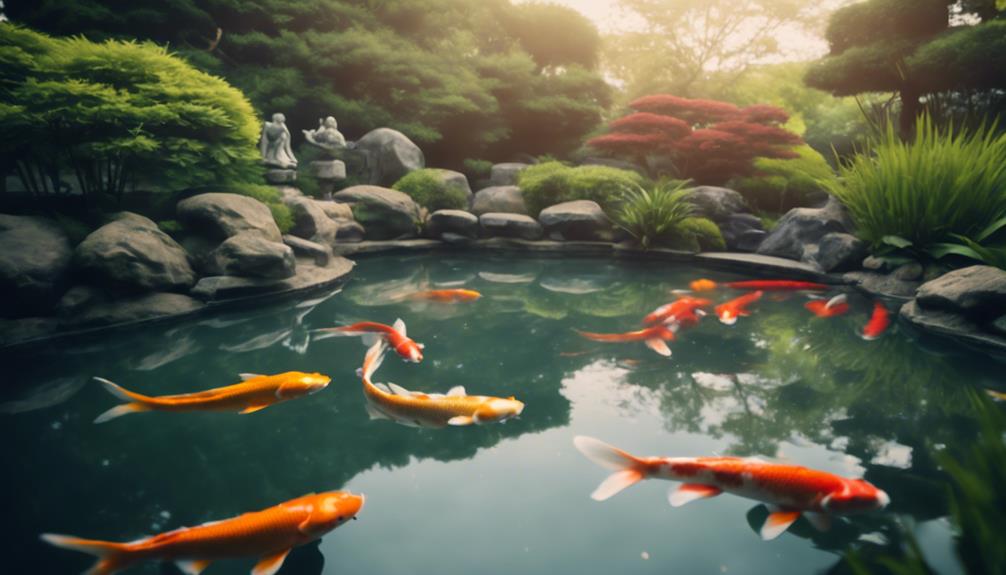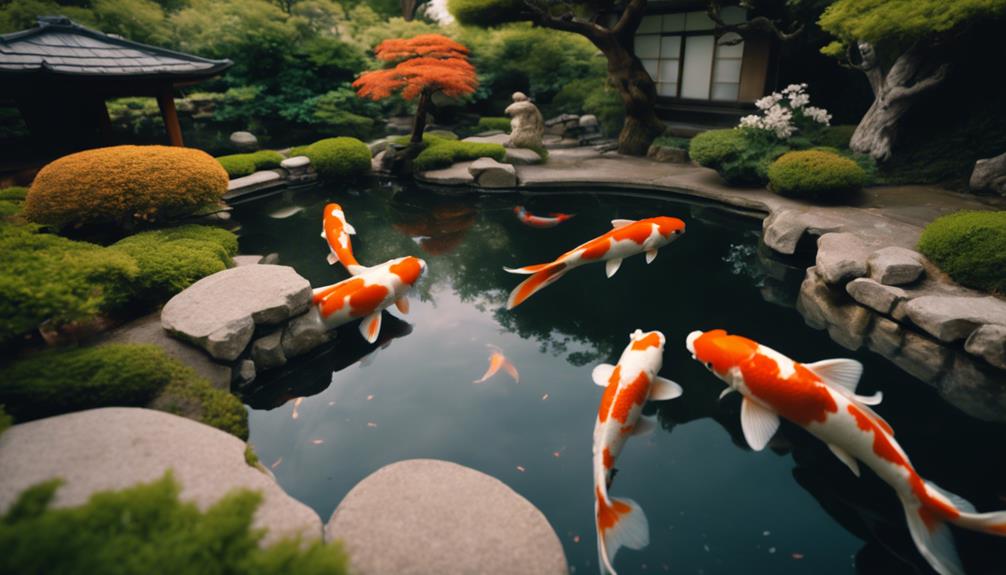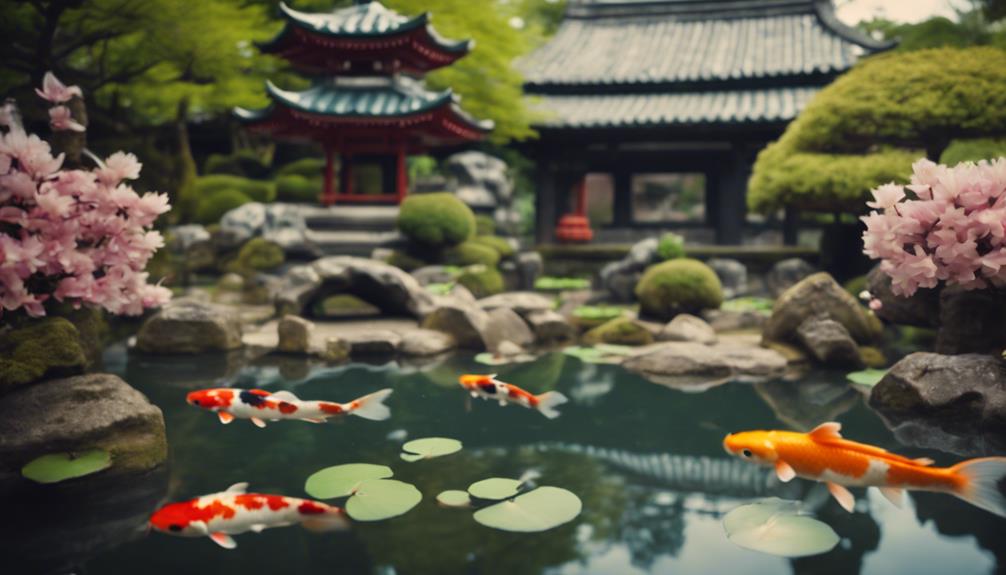You're about to set out on a centuries-old tradition of raising authentic Japanese koi fish. To preserve this tradition, you'll need to understand the history of Nishikigoi, which dates back 200 years to Japan's Niigata prefecture. Authentic Japanese koi are distinguished by their unique characteristics, such as vibrant colors and specific body sizes. You'll need to provide the right environment, including a large pond with moderate temperatures and regular maintenance. Proper care and a deep appreciation for koi symbolism are also essential. As you begin this journey, you'll uncover the intricacies of raising these stunning creatures, and discover the secrets to creating a thriving koi habitat that honors tradition.
Table of Contents
Key Takeaways
- Authentic Japanese koi are distinguished by their unique characteristics, including colors, finish, body size, and pattern steps.
- Traditional breeding practices in Niigata, Japan, emphasize selective breeding for vibrant colors and patterns.
- To raise authentic koi, provide a minimum of 1,000 gallons of water per fish, with moderate temperatures and regular water testing.
- Each variety of authentic Japanese koi has its own distinct characteristics, making them truly special and valuable.
- Proper care, including a balanced diet and social interaction, is essential to preserve the tradition of raising authentic Japanese koi.
Understanding Nishikigoi History
Delving into the rich heritage of Nishikigoi, you'll discover that the term was first used 200 years ago in a village in Japan's Niigata prefecture to describe the vibrantly colored carp that were bred as a food source.
This Traditional Japanese practice of breeding black carp (Magoi) resulted in a rare beauty, with vibrant colors emerging through selective breeding.
In Japan, the word 'koi' is a homophone for the Japanese word for affection or love, making koi a symbol of love and friendship.
You'll find that nobles kept koi as early as the Heian period (794-1185), with breeding later taking place in Yamakoshi Village and Ojiya City, showcasing red and yellow colors with patterns.
Through labor-intensive selective breeding, Nishikigoi were raised in Niigata's fertile soil and climate, both outdoors and indoors, and evaluated for their brightest patterns.
Characteristics of Authentic Koi
As you explore the world of Nishikigoi, you'll find that authentic Japanese koi are distinguished by their unique characteristics, which set them apart from other varieties of koi fish.
These vibrant creatures are judged based on their colors, including Hi, Shiroji, and Sumi, as well as their degrees of finish, body size, and steps in the patterns.
Each variety of authentic Japanese koi has its own distinct characteristics, making them truly special.
The quality of an authentic koi refers to the koi fish's skin, with a common example being a Kohaku having snowy white skin with vivid Hi patterns.
Body conformation is also vital, with an ideal body being full and rounded in a spindle-like shape.
With around 200 varieties of Nishikigoi to choose from, you'll find that the most popular classification is Gosanke, comprising Kohaku, Taisho Sanshoku Sanke, and Showa Sanshoku varieties.
Caring for Japanese Koi Fish

To guarantee the long-term health and happiness of your Japanese koi, it is vital to provide them with a suitable environment and proper care. As a responsible owner, you're making a long-term commitment to care for these ornamental fish, which can live up to 25-35 years with proper care.
Some essential tips to guarantee your Japanese koi thrive:
- Provide a minimum of 1,000 gallons of water per fish, with a mix of shallow and deep areas to prevent freezing and provide adequate space.
- Maintain moderate temperatures between 59-77°F, and adjust their diet according to the water temperature.
- Perform regular water testing and maintenance, including monitoring water levels, temperature, and quality, and performing regular water changes to prevent disease.
- Keep at least three to five koi fish together in a pond to promote their overall well-being, as they're social creatures.
- Regularly check the water quality to guarantee it's suitable for your freshwater fish, and make adjustments as needed to keep your Nishikigoi happy and healthy.
Appreciating Koi Beauty and Symbolism
You'll soon discover that Japanese koi fish are renowned for their stunning beauty and rich symbolism, which have captivated people for centuries. As you explore into the world of koi, you'll appreciate the intricate patterns, vibrant scales, and majestic movements that make them a centerpiece of any Japanese garden. At a Koi Farm, you can witness the mesmerizing sight of hundreds of koi swimming together, their bright colors shimmering in the sunlight.
| Symbolism | Meaning | Significance |
|---|---|---|
| Good Fortune | Prosperity, Success | Welcoming good luck and prosperity into one's life |
| Longevity | Thousand Years | Representing a long and healthy life |
| Friendship | Bonds and Relationships | Strengthening ties with family and friends |
As a koi enthusiast, you'll learn to appreciate the cultural significance of Nishiki-goi, a breed native to Japan. You'll understand why koi have been a symbol of good fortune, longevity, and friendship for centuries. By embracing the beauty and symbolism of koi, you'll become part of a community that values tradition, harmony, and balance.
Building and Maintaining Koi Ponds

Creating a thriving koi pond requires careful planning and attention to detail, starting with a well-designed pond that meets the specific needs of these remarkable fish. You'll want to guarantee your pond is at least 3-4 feet deep to provide a comfortable swimming space for your koi and protect them from predators.
The essential elements to focus on include:
- A pond pump and filtration system to maintain clean and healthy water
- Regular water testing to monitor pH, ammonia, and nitrite levels
- A durable, non-toxic, and UV-resistant pond liner to prevent leaks
- A quarantine tank ready to isolate and treat sick or injured koi
- Proper pump size, with 1,000-2,000 gallons per hour recommended for small ponds
Years ago, koi enthusiasts might've gotten by with a simple pond design, but today's koi keepers understand the importance of a well-maintained environment. By prioritizing these key elements, you'll be well on your way to creating a thriving koi pond that will bring you joy and satisfaction for years to come.
Frequently Asked Questions
What Is the Tradition of the Koi Fish?
You plunge into the tradition of koi fish, uncovering ancient breeding practices, cultural significance, and historical origins tied to fish farming, imperial connections, and legendary status as sacred creatures, symbolizing love, perseverance, and good luck.
What Do Koi Fish Symbolize in Japanese Culture?
You discover that koi fish symbolize cultural significance in Japanese culture, embodying perseverance, good fortune, and spiritual connection, while also representing friendship bonds and the journey of life, holding profound symbolic meaning.
How Do You Keep Japanese Koi?
You'll be surprised to know that koi can live up to 25-30 years with proper care! To keep Japanese koi, you'll need to focus on maintaining ideal water quality, designing a suitable pond, providing balanced fish nutrition, and implementing effective breeding techniques, tank maintenance, water circulation, and filtration systems.
What Is the Myth of the Koi Fish?
You'll discover that, in Asian mythology, koi fish are symbolic creatures, believed to transform into water dragons, bringing good fortune. According to Dragon legends, they're fish spirits, capable of magical transformations, symbolizing perseverance and strength.
Conclusion
As you gaze into the serene waters of your koi pond, remember that preserving tradition means more than just raising fish – it's a connection to the ancient art of Nishikigoi.
Every scale, every color, every nuanced movement whispers secrets of Japan's rich cultural heritage.
By caring for these living jewels, you're not just a keeper, but a guardian of tradition, ensuring the beauty and symbolism of authentic Japanese koi continue to thrive for generations to come.

